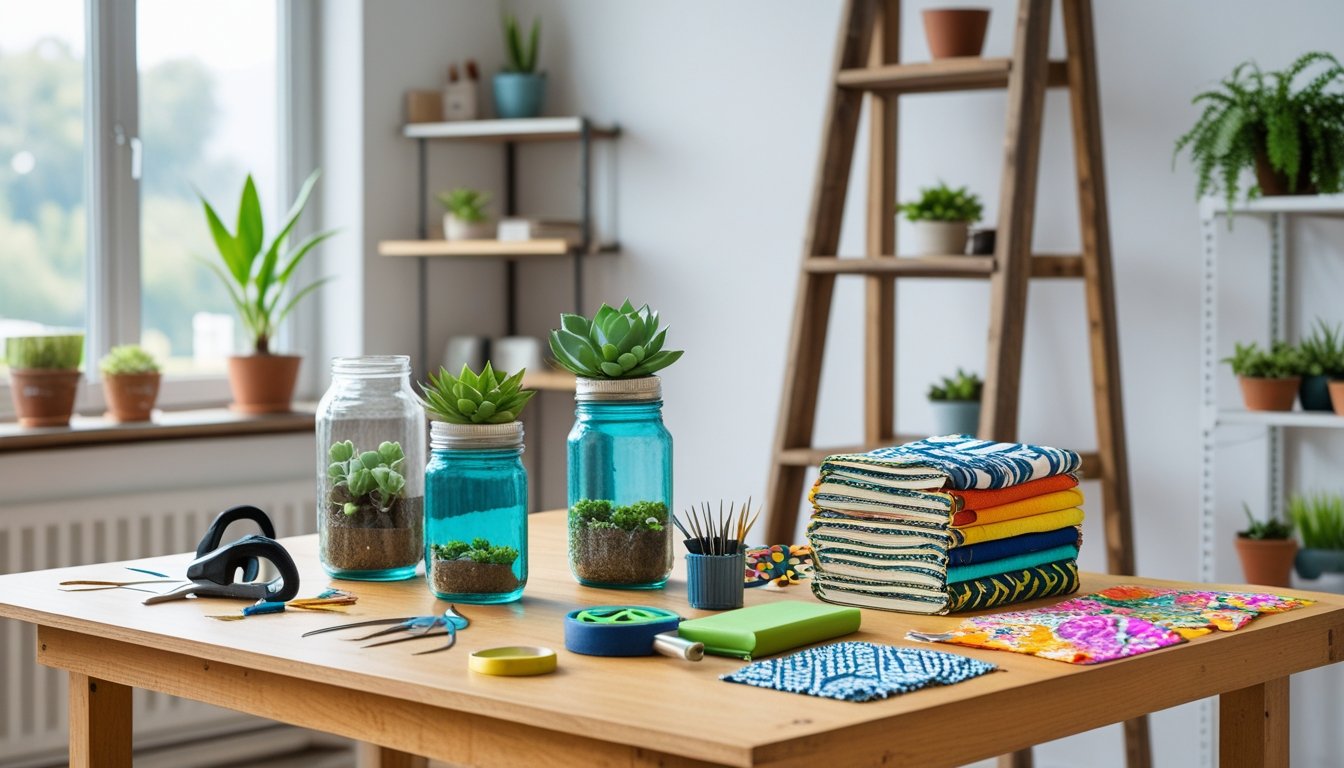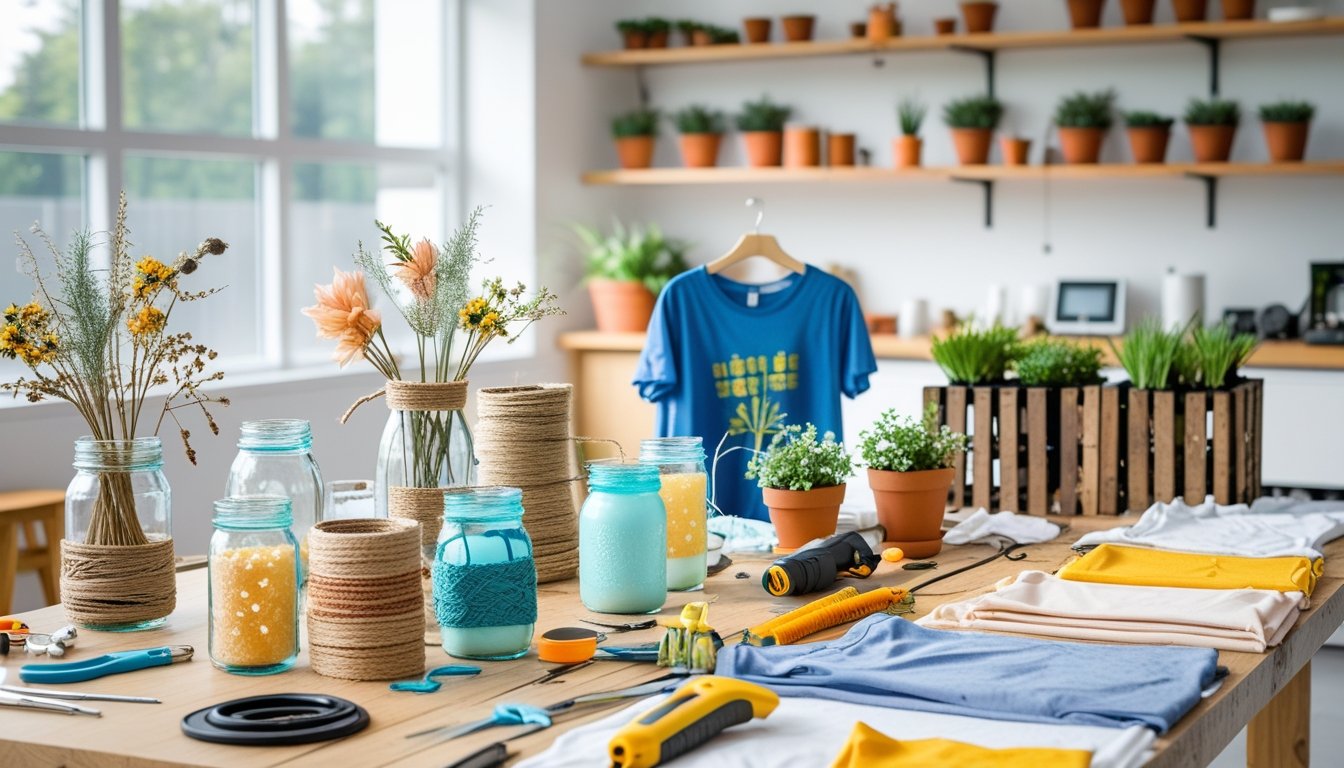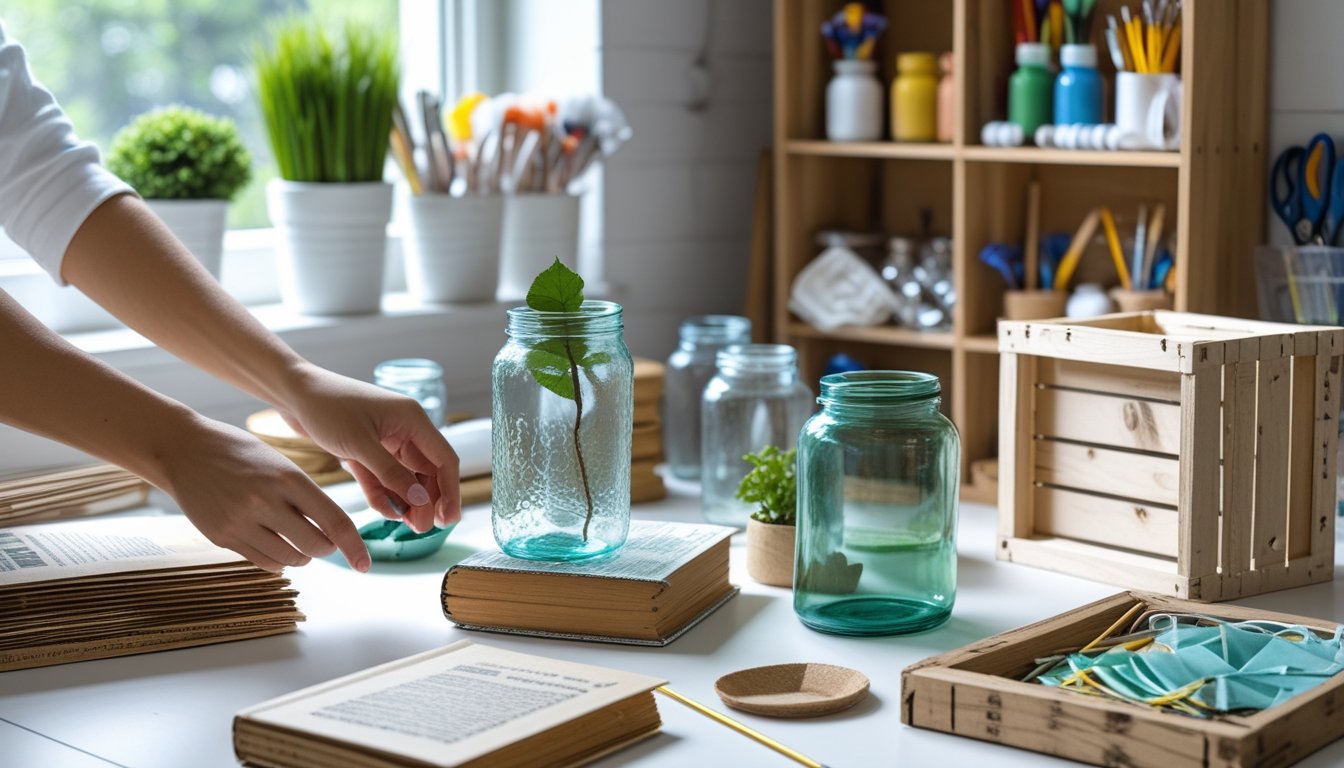Late updated: 13 May 2025 09:05
Written by: Sarah Hollister
Innovative Upcycling Ideas for Everyday Items: Transform Your Home with Creativity
Upcycling offers us the opportunity to transform everyday items into something new and exciting. It's not just about giving a second life to objects but also about fostering creativity and contributing to sustainability. By using materials we already have, we can create functional and stylish items, reducing waste and the need for new resources. This practice benefits the environment and allows us to express our creativity in unique and surprising ways.

Everyday household items like old jeans, worn-out shirts, and cardboard packaging can become the basis for upcycling projects. Whether it's converting fabric remnants into reusable tote bags or turning wood pallets into home decor, there are countless possibilities for what you can create. The real magic lies in seeing potential in what might otherwise be considered waste.
As we dive into the world of upcycling, we'll explore innovative ideas that will inspire you to look at your surroundings with fresh eyes. It's about blending function and aesthetics while championing a more sustainable and mindful lifestyle.
Key Takeaways
- Upcycling transforms everyday items into creative, new uses.
- Everyday items like fabric and wood can be turned into useful creations.
- Embracing upcycling supports sustainability and creativity.
Fundamental Principles of Upcycling Everyday Items

Upcycling everyday items involves transforming waste into innovative products with newfound value. It can distinguish itself from traditional recycling, yielding environmental and creative benefits while supporting sustainable practices.
Understanding Upcycling Versus Recycling
Recycling breaks down materials to create new raw forms, requiring significant energy. Upcycling, on the other hand, involves creative reuse by modifying existing items to enhance value, thus conserving resources. For example, turning old wine bottles into planters retains their original form, diverging from recycling's energy-intensive processes. This method not only reduces waste but also encourages individual expression and creativity. When choosing upcycling over recycling, we place emphasis on repurposing the materials, extending their lifecycle substantially. This mindful approach benefits both our communities and ecosystems.
Benefits of Repurposing and Creative Reuse
Repurposing offers an array of advantages. Creative reuse allows us to construct new and functional items without consuming new resources. Take a wooden pallet; redesign it as a garden bed. This reduces landfill contributions and promotes a more resourceful lifestyle. Economically, it translates into cost savings by minimising the need for new purchases.
Moreover, engaging in upcycling activities fosters a sense of community and collaboration. Workshops and shared projects encourage collective problem-solving. This, in turn, maximises the utility of each item that might otherwise be discarded. Hence, these efforts contribute positively to environmental wellness and social cohesion.
How Upcycling Supports Sustainability
By adopting upcycling practices, we significantly reduce our environmental footprint. This creative reuse supports the sustainable principle of reducing consumption. Rather than exploiting new resources, existing materials are rejuvenated, supporting a circular economy. Upcycling encourages innovation, prompting us to view waste materials as potential treasures.
Furthermore, products created through upcycling inspire cultural changes in consumption. They shift societal norms away from disposable habits to a more sustainable and deliberate use of resources. As we embrace this approach in our everyday lives, it not only preserves resources but also embeds sustainability deeply within our communities. Through upcycling, we indeed make strides towards a healthier planet.
Innovative Upcycling Ideas for Common Household Items
In our homes, numerous everyday objects can be transformed into functional and stylish items. Whether it's glass jars turned into beautiful vases or old clothing redesigned into something new, plenty of creative possibilities exist. Here, we discuss various methods for repurposing common household items effectively.
Repurposing Glass Jars and Mason Jars
Glass jars and mason jars offer endless opportunities for upcycling. Mason jars, for instance, can serve as beautiful storage solutions for pantry items like grains and spices.
They can also be converted into unique candle holders by filling them with wax and a wick. These jars can be designed with paint or fabric to complement existing decor. Additionally, old glass jars labelled and organised can act as ideal containers for bathroom essentials.
You might also consider using them as planters. A glass jar makes for a charming small succulent pot, creating a vivid green touch in any room.
Transforming Clothing and Textiles
Our wardrobes often contain clothing that we no longer wear, but there's a myriad of ways to upcycle these textiles. Old T-shirts can be easily transformed into reusable shopping bags.
If you're handy with a sewing machine, creating quilts from diverse fabric patches can be wonderful. Jeans can be cut and assembled into trendy handbags or durable aprons. For knitting enthusiasts, consider unravelling unwanted jumpers and using the yarn for new projects.
Even smaller textiles, like socks, can be turned into cosy heating pads when filled with rice and warmed in the microwave.
Upcycling Furniture for Home Décor
Another area of potential creativity is furniture upcycling. Old furniture can be given a new lease on life. A simple coat of paint can dramatically change a piece's appearance, turning a dated side table into a chic accent piece.
Add new handles or knobs to cabinets or dressers for an updated look. You might even combine parts from various furniture pieces to create something entirely new and unique. Upholstery can be replaced or repaired to rejuvenate ageing chairs and sofas, saving us money on new purchases and matching our home decor perfectly.
Creative Uses for Plastic Containers
Finally, plastic containers can also find new uses in our homes. Empty yoghurt pots and larger plastic tubs serve well as planters for herbs or small plants, aiding gardening efforts.
Plastic bottles, if cut appropriately, can become useful for bird feeders or organisers for cables and small items. With a bit of ingenuity, these containers can also be used to create simple watering systems for houseplants. Carefully poke holes in the lid and invert the container into the soil.
These options not only reduce waste but also add personal touches to our living spaces.
Frequently Asked Questions

We address some of the most common questions about upcycling, exploring creative projects for beginners and profitable opportunities in the market. Let's take a closer look at how everyday items can be transformed into decor and practical solutions.
How can one transform daily household items into upcycled decor?
We can turn old jars into beautiful candle holders or use wine corks to create coasters. Simple decorative touches like painting or adding fabric can also refresh old furniture. Creativity and a bit of time allow us to reinvent items that might otherwise be discarded.
What are some straightforward upcycling projects suitable for beginners?
Beginners can start with easy projects, such as turning tin cans into planters or creating tote bags from old T-shirts. These projects require minimal tools and skills, making them accessible to everyone. Starting with familiar items helps build confidence and skills.
Which upcycled products are known to be the most profitable to sell?
Small furniture items, such as customised chairs and tables, often sell well. Handmade jewellery and unique home decor, like picture frames from reclaimed wood, also attract interest. Finding a niche market and offering quality craftsmanship increase the likelihood of profitable sales.
What materials are the easiest to start with for upcycling novices?
Some of the easiest materials to use are glass jars, cardboard, and old clothing. These materials are readily available and require minimal effort to transform. With a bit of paint or fabric, they can be turned into something entirely new, offering a gentle learning curve for newcomers.
In what ways can students incorporate upcycling into their school projects?
Students might consider using upcycled materials for art projects or science experiments. Examples include creating models from recycled materials or designing costumes for a play. These projects encourage innovation and problem-solving, while promoting environmental responsibility.
What items are commonly upcycled and have a high demand in the market?
Popular items include vintage-style furniture, clothing accessories, and home decor pieces. Products like upcycled denim bags or refurbished lamps often appeal to eco-conscious consumers. These items combine functionality with aesthetics, making them attractive options for buyers seeking sustainable alternatives.
